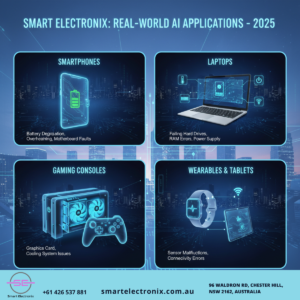
Let’s face it—no one likes being without their smartphone, laptop, or tablet when it suddenly breaks down. Waiting days or even weeks for a repair can feel frustrating, especially when these devices are essential to your work, studies, or daily routine. In 2025, however, the repair game is changing, and AI-assisted diagnostics are at the heart of this transformation. At Smart Electronics, we’re leading the way in Australia by using artificial intelligence to reduce repair times and make the process faster, smarter, and more reliable.
Why Traditional Repairs Take Too Long
In traditional repair models, technicians often spend hours manually testing, troubleshooting, and running diagnostics on faulty devices. This can cause delays, especially when multiple issues are involved or when parts need to be ordered. Human error may also lead to misdiagnoses, further extending repair times and increasing costs.
How AI Is Transforming Device Repairs
Artificial intelligence brings a game-changing edge to the world of electronics repair. Instead of relying solely on manual inspection, AI-driven diagnostic tools analyze devices in real time, identifying problems more quickly and with greater accuracy. Here’s how it works:
- Instant Fault Detection: AI systems scan internal hardware and software to pinpoint exact faults in minutes.
- Predictive Analysis: AI not only identifies current issues but can also predict potential future failures, saving customers from repeated visits.
- Faster Turnaround: With AI assisting technicians, repairs that once took days can now be completed in just a few hours.
- Smart Recommendations: AI tools suggest the most efficient repair methods, ensuring technicians choose the best approach.
Benefits for Customers
- Reduced Wait Times: Devices get fixed faster, minimizing disruption to your personal or professional life.
- Cost-Effective Repairs: Accurate diagnostics prevent unnecessary replacements, saving customers money.
- Improved Reliability: AI minimizes the risk of human error, ensuring consistent repair quality.
- Enhanced Transparency: Customers receive detailed diagnostic reports, so they know exactly what went wrong and how it’s being fixed.
Real-World Applications in 2025
 At Smart Electronix, AI is now being used across a wide range of services:
At Smart Electronix, AI is now being used across a wide range of services:
- Smartphones: Detecting battery degradation, overheating issues, or motherboard faults instantly.
- Laptops: Identifying failing hard drives, RAM errors, or power supply problems without lengthy manual testing.
- Gaming Consoles: Pinpointing graphics card or cooling system issues before they worsen.
- Wearables and Tablets: Quickly recognizing sensor malfunctions or connectivity errors.
AI vs Human Technicians
While AI is a powerful tool, it doesn’t replace technicians—it empowers them. Think of AI as a digital assistant that provides data-driven insights, allowing technicians to focus on precision repairs. This combination of human expertise and AI efficiency leads to faster, more dependable results.
The Future of AI-Assisted Repairs
 Looking ahead, AI will only become more advanced. Self-diagnosing devices may soon alert you to issues before they even occur. Smart repair systems could automatically order parts as soon as a fault is detected. At Smart Electronics, we’re committed to staying ahead of the curve, ensuring Australians always have access to the fastest and most reliable repair services.
Looking ahead, AI will only become more advanced. Self-diagnosing devices may soon alert you to issues before they even occur. Smart repair systems could automatically order parts as soon as a fault is detected. At Smart Electronics, we’re committed to staying ahead of the curve, ensuring Australians always have access to the fastest and most reliable repair services.
Final Thoughts
AI-assisted diagnostics are revolutionizing how we repair devices in 2025. By reducing repair times, improving accuracy, and cutting costs, Smart Electronix is making life easier for customers across Australia. Whether it’s your phone, laptop, or console, our AI-driven approach ensures your device spends less time in the repair shop and more time in your hands.
At Smart Electronics, we’re not just fixing gadgets—we’re redefining the future of device care with the power of AI. If you’re ready for faster, smarter, and more reliable repairs, visit Smart Electronix today.
